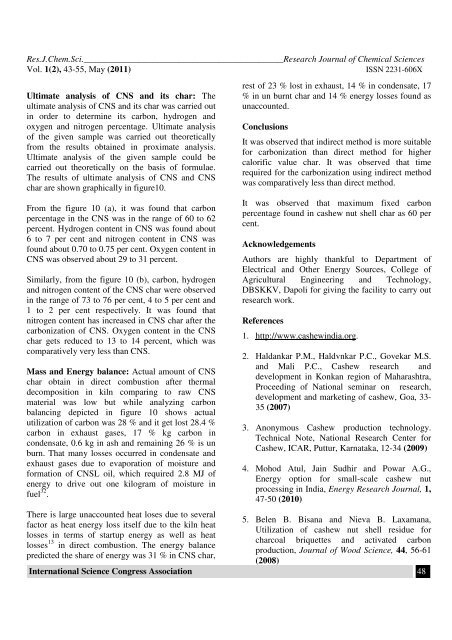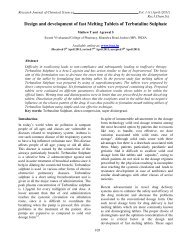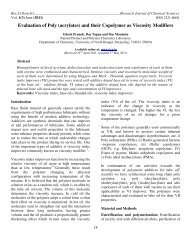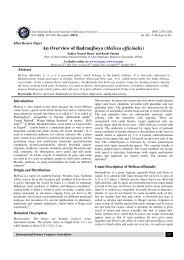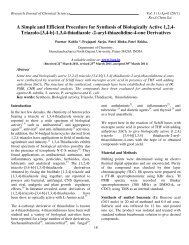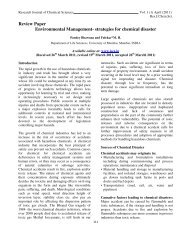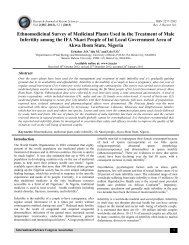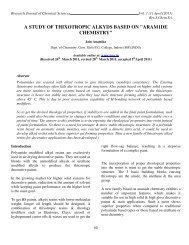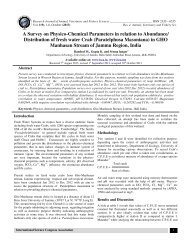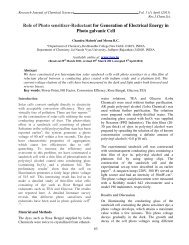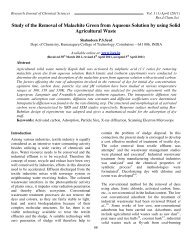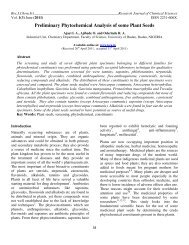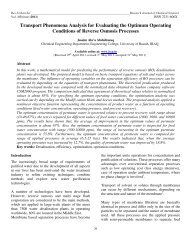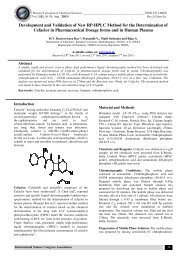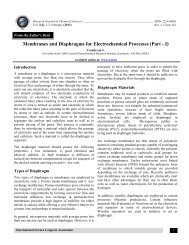Study of Carbonization for Cashew Nut Shell - ISCA
Study of Carbonization for Cashew Nut Shell - ISCA
Study of Carbonization for Cashew Nut Shell - ISCA
Create successful ePaper yourself
Turn your PDF publications into a flip-book with our unique Google optimized e-Paper software.
Res.J.Chem.Sci._____________________________________________Research Journal <strong>of</strong> Chemical Sciences<br />
Vol. 1(2), 43-55, May (2011) ISSN 2231-606X<br />
Ultimate analysis <strong>of</strong> CNS and its char: The<br />
ultimate analysis <strong>of</strong> CNS and its char was carried out<br />
in order to determine its carbon, hydrogen and<br />
oxygen and nitrogen percentage. Ultimate analysis<br />
<strong>of</strong> the given sample was carried out theoretically<br />
from the results obtained in proximate analysis.<br />
Ultimate analysis <strong>of</strong> the given sample could be<br />
carried out theoretically on the basis <strong>of</strong> <strong>for</strong>mulae.<br />
The results <strong>of</strong> ultimate analysis <strong>of</strong> CNS and CNS<br />
char are shown graphically in figure10.<br />
From the figure 10 (a), it was found that carbon<br />
percentage in the CNS was in the range <strong>of</strong> 60 to 62<br />
percent. Hydrogen content in CNS was found about<br />
6 to 7 per cent and nitrogen content in CNS was<br />
found about 0.70 to 0.75 per cent. Oxygen content in<br />
CNS was observed about 29 to 31 percent.<br />
Similarly, from the figure 10 (b), carbon, hydrogen<br />
and nitrogen content <strong>of</strong> the CNS char were observed<br />
in the range <strong>of</strong> 73 to 76 per cent, 4 to 5 per cent and<br />
1 to 2 per cent respectively. It was found that<br />
nitrogen content has increased in CNS char after the<br />
carbonization <strong>of</strong> CNS. Oxygen content in the CNS<br />
char gets reduced to 13 to 14 percent, which was<br />
comparatively very less than CNS.<br />
Mass and Energy balance: Actual amount <strong>of</strong> CNS<br />
char obtain in direct combustion after thermal<br />
decomposition in kiln comparing to raw CNS<br />
material was low but while analyzing carbon<br />
balancing depicted in figure 10 shows actual<br />
utilization <strong>of</strong> carbon was 28 % and it get lost 28.4 %<br />
carbon in exhaust gases, 17 % kg carbon in<br />
condensate, 0.6 kg in ash and remaining 26 % is un<br />
burn. That many losses occurred in condensate and<br />
exhaust gases due to evaporation <strong>of</strong> moisture and<br />
<strong>for</strong>mation <strong>of</strong> CNSL oil, which required 2.8 MJ <strong>of</strong><br />
energy to drive out one kilogram <strong>of</strong> moisture in<br />
fuel 32 .<br />
rest <strong>of</strong> 23 % lost in exhaust, 14 % in condensate, 17<br />
% in un burnt char and 14 % energy losses found as<br />
unaccounted.<br />
Conclusions<br />
It was observed that indirect method is more suitable<br />
<strong>for</strong> carbonization than direct method <strong>for</strong> higher<br />
calorific value char. It was observed that time<br />
required <strong>for</strong> the carbonization using indirect method<br />
was comparatively less than direct method.<br />
It was observed that maximum fixed carbon<br />
percentage found in cashew nut shell char as 60 per<br />
cent.<br />
Acknowledgements<br />
Authors are highly thankful to Department <strong>of</strong><br />
Electrical and Other Energy Sources, College <strong>of</strong><br />
Agricultural Engineering and Technology,<br />
DBSKKV, Dapoli <strong>for</strong> giving the facility to carry out<br />
research work.<br />
References<br />
1. http://www.cashewindia.org.<br />
2. Haldankar P.M., Haldvnkar P.C., Govekar M.S.<br />
and Mali P.C., <strong>Cashew</strong> research and<br />
development in Konkan region <strong>of</strong> Maharashtra,<br />
Proceeding <strong>of</strong> National seminar on research,<br />
development and marketing <strong>of</strong> cashew, Goa, 33-<br />
35 (2007)<br />
3. Anonymous <strong>Cashew</strong> production technology.<br />
Technical Note, National Research Center <strong>for</strong><br />
<strong>Cashew</strong>, ICAR, Puttur, Karnataka, 12-34 (2009)<br />
4. Mohod Atul, Jain Sudhir and Powar A.G.,<br />
Energy option <strong>for</strong> small-scale cashew nut<br />
processing in India, Energy Research Journal, 1,<br />
47-50 (2010)<br />
There is large unaccounted heat loses due to several<br />
factor as heat energy loss itself due to the kiln heat<br />
losses in terms <strong>of</strong> startup energy as well as heat<br />
losses<br />
International Science Congress Association 48<br />
13 in direct combustion. The energy balance<br />
predicted the share <strong>of</strong> energy was 31 % in CNS char,<br />
5. Belen B. Bisana and Nieva B. Laxamana,<br />
Utilization <strong>of</strong> cashew nut shell residue <strong>for</strong><br />
charcoal briquettes and activated carbon<br />
production, Journal <strong>of</strong> Wood Science, 44, 56-61<br />
(2008)


